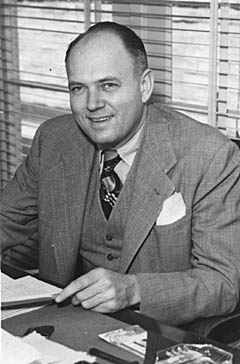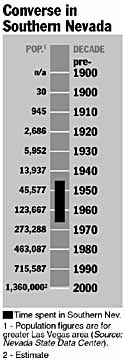Edmund Converse



Bonanza Airlines pilot Dick Hall had just left Reno on a bright June day in 1947 and had climbed to an altitude where he could see the azure waters of Lake Tahoe out the starboard window. A call came from the Reno tower instructing him to return to the field.
Annoyed, Hall demanded to know why. He was told the Washoe County sheriff’s office had ordered the plane back because it carried two criminal suspects. Hall paused, then pressed the transmit button on the microphone.
“Negative,” he said, explaining Las Vegas was expecting bad weather and he wanted to arrive there ahead of it. He signed off.
The flight landed on schedule at Las Vegas, beneath cloudless, sunny skies, and local deputies took the men into custody.
Later that day, Edmund Converse, the founder and president of the tiny company, confronted Hall and asked him why he had ignored the Reno tower.
“What?” exclaimed Hall. “And have those two guys demand their fare back? This way, we flew them to Las Vegas and kept the fare.”
Converse must have laughed. He tried to hire people who were aviation-savvy and loaded with chutzpah.
“He was scared to death of airplanes; I don’t think he ever became comfortable in one,” laughs Florence Murphy, the first female commercial pilot in Nevada history. She served as Converse’s vice president and corporate secretary from 1946 until 1958, and was the person Converse relied upon to recruit the highest quality people.
The story of Edmund Converse is not a Horatio Alger story. His family was extremely wealthy, having made most of its fortune in the stock market and in banking.
“He told me that he was the first man in his family in three generations to have worked,” says Murphy. “He said he wanted to do something with himself by himself.”
He succeeded. Bonanza Airlines was the state’s first successful commuter airline, the first to offer jet passenger service to Las Vegas and a major factor in the city’s postwar tourism boom.
Converse was born in New York in 1906. When little Eddie was 2, his family bought a cattle ranch in California, where he grew up and attended public schools. He attended Stanford University, graduated with a bachelor’s degree in economics in 1928.
“His first job was at Banker’s Trust Company in New York, which his family owned,” says Murphy. “He made $75 a week and went to work in a chauffer-driven limousine.”
After two years, he decided to attend law school.
“His grandfather had an endowment at Stanford University, which I guess goes back a long, long time,” says Murphy. “He told me that this gift that his grandfather made to the law school haunted him while he went to Stanford. When he went to his first class, his instructor said, ‘I hope you don’t think you’re going to get by in my class just because your grandfather gave all this money.’ It was an embarrassment to him, and it hurt him, and I felt sorry for him.”
He earned his law degree in 1934, and practiced law until 1937, when he was hired onto the staff of a Republican senator from New Hampshire.
In World War II, he was assigned to Naval Intelligence. During the war, he visited Las Vegas, and found it to be teeming with optimistic, self-made people, precisely the environment he sought. He bought a house and made plans to start a law practice in Las Vegas.
At the time, Las Vegas was served by two commercial airlines. Western Airlines provided service from Los Angeles, and TWA had one stop in each direction on its Newark-San Francisco route. The best way to get to Reno was to drive the two-lane blacktop or charter a plane. There was no scheduled service between Nevada’s two largest cities.
Converse had made some friends soon after his arrival. They included Charlie Keene, a pilot who had flown charters in California, and June Simon, daughter of “Pop” Simon, the man who built the airfield that would become Nellis Air Force Base. June was an officer in the Las Vegas Chamber of Commerce, and believed that the future of Las Vegas was in making it easily accessible to tourists. A Las Vegas-based airline would make it so, the trio decided, and Converse had the deep pockets to create one.
Deep, but not bottomless. The firm was incorporated Dec. 31, 1945, but its assets consisted of some furniture, a ticket counter in the lobby of the El Rancho Vegas, and a leased single-engine, three-place Cessna Skymaster. It was strictly a charter business, and it operated from the primitive Sky Haven landing field built by John and Florence Murphy in 1941. It had no weather station, no communications gear, no landing lights. Converse and Simon would take turns running out and lighting flare pots along the runway when Charlie Keene was due in from a charter.
The following year, Bonanza moved from Sky Haven to Alamo Airport, now McCarran International, then a few months later, to McCarran Field, now Nellis Air Force Base. The Bonanza fleet had expanded to include two Piper Cubs, a Stearman biplane and a twin-engine, five-place Cessna.
In 1946, the Federal War Assets Administration noticed that it had a huge surplus of twin-engine C-47s, the paratroop-dropping, supply-hauling workhorses of the war. They were sold as-is and where-is, cheap.
It also was possible to lease a C-47 from the government, which Converse decided to do. Keene and two other pilots went to Oak Ridge, Tenn., to pick up what they called “the bucket of bolts” and bring it back to Las Vegas where they would transform it into its civilian counterpart, a Douglas DC-3 airliner.
Coincidentally, the day they departed Tennessee, the national railroad union called a general strike. There were only two ways to move freight, by truck or plane. Bonanza’s phones began to ring steadily.
Farmers in the Moapa Valley were frantic. They had to move their vegetable crops to market or lose them. The redecoration of the “bucket” was put on hold while basic mechanical repairs were made.
By early spring 1946, Bonanza was in the produce-shipping business. Everyone from Converse on down pitched in to load crate after crate of celery and tomato bedding plants, which went to gardeners all over the nation, as far east as Rochester, N.Y.
With the strike settled, the old war veteran was made over into an elegant lady of the skies, and made its inaugural Reno-Las Vegas flight on Aug. 6, 1946. Initially, there were three round-trip flights a week, about all that a single plane could manage. Weekends were reserved for charters, the most profitable part of Bonanza operations.
One day, after the plane had been loaded with passengers, one of them looked out the window and saw a tanker truck pull up to the plane and begin fueling it.
“Well, I guess they had to sell us the tickets first so they’d have dough enough to buy gasoline to make the flight.” The man was joking, but he also was partly correct. Bonanza had no income other than passenger fares and charters. No mail contract like Western, no federal subsidy.
Converse huddled with one of his stockholders, former Nevada Gov. Morley Griswold, and hit upon a simple yet effective way to boost passenger counts. Delegations from Bonanza and the Las Vegas Chamber of Commerce traveled to Reno and convinced that city’s chamber of commerce that it would be to their mutual advantage to advertise their attractions in each others’ cities. In one of the rare times in Nevada history when Reno and Las Vegas have cooperated in anything, advertising for Reno began to appear in the Las Vegas Review-Journal and Age. Ads for Las Vegas began to appear in the Reno Evening Gazette and the Nevada State Journal.
It worked. Converse reported a small profit for April 1947, the first ever for Bonanza, and stops were added in Tonopah and Hawthorne. More of the sturdy DC-3s were purchased, eventually totaling 10.
By 1949, Bonanza had been certificated as an interstate carrier, and was flying from Las Vegas to Phoenix with several intermediate stops. Converse was fighting for new routes, mail contracts and subsidies. It was a long and grueling process. Converse and his dedicated staff became adept hoop-jumpers, and were assisted through interminable hearings by Las Vegas civic leaders. By 1958, Bonanza was serving 20 cities in four states.
Though reliable and easy to service, the old airplanes were simply obsolete. They weren’t pressurized, meaning they had a limited ceiling, and had to fly through, rather than over, rough weather. They were slow, taking two hours from Las Vegas to Reno.
In mid-1958, Bonanza Airlines, already a public company, got approval from the Securities and Exchange Commission to issue $1,175,000 in stocks. At the same time, the Civil Aeronautics Board approved a $4,324,500 loan. All that money was needed for Bonanza’s next great leap forward — into the jet age.
Converse spent time in Europe looking for just the right aircraft. American aircraft makers were more interested in chasing military contracts and long-range, high-capacity passenger jets than in producing mid-size passenger jets. He found the prop jet Fokker-Fairchild F27A. It carried 40 passengers, twice that of the DC-3s, and had a cruising speed of 300 mph. Converse ordered six of them at $820,000 each, and spent more than $150,000 on a modern corporate headquarters at McCarran Field.
The new Bonanza paint scheme, tangerine and black, plus the number of flights arriving and departing daily, made it a familiar part of the Las Vegas skyscape. Bonanza was Nevada’s airline.
There were many swelled chests locally when Converse announced in June 1964, that Bonanza had ordered three state-of-the-art Douglas DC-9 fanjets, capable of carrying 64 passengers at 560 mph.
Converse was justifiably proud of Bonanza’s safety record. It was perfect.
But 1964 was a bad year for aviation in Nevada. In March, an airliner had gone down near Lake Tahoe, killing 85 people. In May, an F-105 fighter jet crashed into a North Las Vegas residential neighborhood, killing five. Then, in November, Bonanza Airlines had its one and only air disaster.
Shortly after 8 p.m. on Nov. 15, a Sunday, Hank Fitzpatrick was at the controls of his Fokker-Fairchild F27A, Flight 114 from Phoenix, about 12 miles southwest of McCarran Airport over the Spring Mountains. A freak snowstorm, the worst to hit the area in 15 years, had reduced visibility to zero. Two other planes ahead of Flight 114 had attempted to make the approach, and were diverted to California. Fitzpatrick was on a ground control approach, meaning McCarran tower was guiding him in.
Fitzpatrick radioed the tower at 8:23, “Ah, roger, one-fourteen is out of seven,’ meaning he had dropped below 7,000 feet. About a minute later, he radioed, “Bonanza Flight 144 is …” and the plane disappeared from radar.
The plane clipped the summit of a 5,000-foot peak and disintegrated, killing all 29 people aboard.
“Another 10 feet and the pilot would have cleared the peak,” said Sheriff Ralph Lamb, whose men would have the arduous and unhappy duty of fighting their way through the giant snowdrifts to recover the victims.
The next year, a disagreement erupted between Bonanza and Clark County over the taxes to be levied on the new DC-9 jets, which were to go into service in 1966. Offered a better tax deal by Phoenix, Converse announced that Bonanza would pull out of Las Vegas and make its new headquarters in the Valley of the Sun.
Ultimately, Bonanza merged with Pacific Airlines and West Coast Airlines to form Air West, which was shortly thereafter purchased by Howard Hughes. Converse died in the Phoenix suburb of Scottsdale in 1981.
“Eddie was a good man,” says Murphy. “He could be proud of what he accomplished, and that he accomplished it himself.”
Part I: The Early Years
Part II: Resort Rising
Part III: A City In Full












